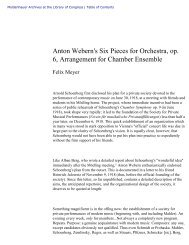Country Profile: Cuba - American Memory - Library of Congress
Country Profile: Cuba - American Memory - Library of Congress
Country Profile: Cuba - American Memory - Library of Congress
Create successful ePaper yourself
Turn your PDF publications into a flip-book with our unique Google optimized e-Paper software.
<strong>Library</strong> <strong>of</strong> <strong>Congress</strong> – Federal Research Division <strong>Country</strong> <strong>Pr<strong>of</strong>ile</strong>: <strong>Cuba</strong>, September 2006<br />
and a projected surplus <strong>of</strong> US$2.8 billion in 2006. Tourism and the provision <strong>of</strong> health-care<br />
services to Venezuela account for most <strong>of</strong> the increase in services earnings.<br />
Balance <strong>of</strong> Payments: Until 1990 the Soviet trading bloc, the Council for Mutual Economic<br />
Assistance (CMEA), financed <strong>Cuba</strong>’s current account deficit. During 1992–2003, <strong>Cuba</strong>’s<br />
restricted access to international capital kept the country’s current account deficit under 2 percent<br />
<strong>of</strong> gross domestic product (GDP). After deficits in the current account <strong>of</strong> US$653 million in<br />
2001, US$276 million in 2002, and US$136 million in 2003, the country’s balance <strong>of</strong> payments<br />
enjoyed a surplus <strong>of</strong> US$134 million in 2004 and US$143 million in 2005, or about 0.2 percent<br />
<strong>of</strong> GDP in 2004 and 0.1 percent in 2005. The positive current account balance in 2004–5 was<br />
due primarily to <strong>Cuba</strong>’s almost regular annual surpluses in the services balance, mainly as a<br />
result <strong>of</strong> strong revenues from international tourism and other services (such as health and<br />
education services exported to Venezuela in exchange for cheap oil), as well as new sources <strong>of</strong><br />
financing from China and high nickel prices. The current account deficit was expected to be a<br />
relatively low US$374 million in 2006 (0.9 percent <strong>of</strong> GDP) and US$358 million in 2007 (0.8<br />
percent <strong>of</strong> GDP).<br />
On the capital account ledger, long-term capital (net) in 2004 totaled US$462 million; net direct<br />
investments, US$200 million; net other long-term capital inflows, US$670 million; other capital,<br />
US$922 million; and variation in reserves, –US$1.5 million. The country’s estimated hardcurrency<br />
international reserves reached US$2.1 billion in 2004, US$2.2 billion in 2005, and an<br />
estimated US$2.4 billion in 2006. The increase since 2003, when reserves totaled only US$638<br />
million, has been attributed in part to Fidel Castro’s ban in November 2004 on the use <strong>of</strong> U.S.<br />
dollars on the island.<br />
External Debt: Although it still owes the Russian Federation more than US$20 billion, <strong>Cuba</strong><br />
reportedly has agreed to make repayments in the form <strong>of</strong> goods, such as fuel and sugar. It<br />
remains unconfirmed how much external hard-currency debt grew in 2004, but the increase was<br />
about US$500 million according to one estimate. In 2005 the island’s hard-currency debt, on<br />
which <strong>Cuba</strong> defaulted in 1986, was owed mainly to European and Latin <strong>American</strong> governments<br />
and totaled about US$12.5 billion, or approximately 35 percent <strong>of</strong> gross domestic product<br />
(GDP). External debt was expected to reach US$13.2 billion in 2006. Debt service in 2005<br />
amounted to just over US$1 billion, and the due debt-service ratio was 13.9 percent. Official debt<br />
is almost all bilateral, such as with Japanese and European creditors, because <strong>Cuba</strong> has no access<br />
to the major multilateral financial institutions.<br />
Foreign Investment: Under <strong>Cuba</strong>’s 1995 Foreign Investment Act, all sectors are open to foreign<br />
capital except defense, public health care, and education. Foreign investors can freely repatriate<br />
pr<strong>of</strong>its and dividends. U.S. investors are barred from <strong>Cuba</strong> by U.S. legislation. The unresolved<br />
issue <strong>of</strong> U.S. property claims also has deterred investors from other countries. Most foreign<br />
investments to date have been in nickel mining, oil, tourism, and telecommunications. Net direct<br />
foreign investment flows totaled US$200 million in 2004 and US$500 million in 2005 and a<br />
projected US$620 million in 2006 and US$630 million in 2007. Major new trade agreements,<br />
investment commitments, and credit lines from China and Venezuela provided a significant<br />
boost in 2005 and were expected to continue to do so in 2006–7.<br />
18



![Albert Einstein Papers [finding aid]. Library of Congress. [PDF ...](https://img.yumpu.com/21604228/1/190x245/albert-einstein-papers-finding-aid-library-of-congress-pdf-.jpg?quality=85)





![American Colony in Jerusalem Collection [finding aid]. Library of ...](https://img.yumpu.com/17941275/1/190x245/american-colony-in-jerusalem-collection-finding-aid-library-of-.jpg?quality=85)



![Piccard Family Papers [finding aid]. - American Memory - Library of ...](https://img.yumpu.com/17941234/1/190x245/piccard-family-papers-finding-aid-american-memory-library-of-.jpg?quality=85)


